Dupa plasarea solicitării de comandă, in sectiunea Istoric puteti vedea cate solicitări de comandă mai avem de procesat inaintea dumneavoastra
Program de lucru: Luni - Vineri 9:00 - 18:00, pauza 13:00 - 14:00.
Se efectueaza lucrari de mentenanta la site si pot aparea erori. In cazul in care intampinati erori va rugam sa reincercati mai tarziu.
Ridicarea personala este disponibila pentru comenzile achitate in avans. Se pot ridica dupa ce sunt pregatite.
No products
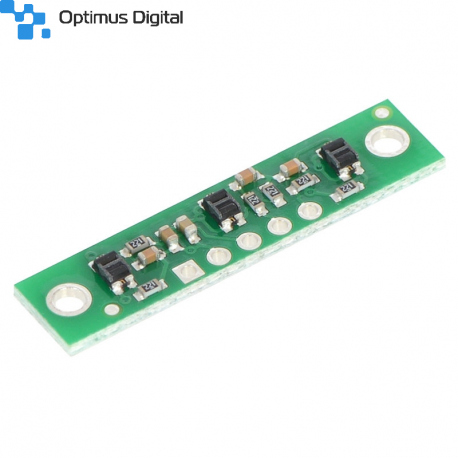 View larger
View larger
QTR-3RC Infrared Reflectance Sensor Array
0104110000014733
New product
This compact module packs three IR LED/phototransistor pairs onto a 1.25" x 0.3" board. The sensors are mounted on a 0.375" pitch, allowing this array to be used as a minimal detector for a line-following robot. Each sensor provides a separate digital I/O-measurable voltage output.
See description for more details about the product.
Add to cart now!
This product is no longer in stock
- Write a review
- Remove this product from my favorite's list.
- Add this product to my list of favorites.
More info
Overview
The QTR-3RC reflectance sensor array requires digital I/O lines to take readings. The similar QTR-3A reflectance sensor array is available with analog outputs.
Functional Description
The QTR-3RC reflectance sensor array is intended as a line sensor, but it can be used as a general-purpose proximity or reflectance sensor. The module is a convenient carrier for three IR emitter and receiver (phototransistor) pairs. With sensors spaced at intervals of 0.375" (9.525 mm) along of the board’s longer axis, this array works well as a minimal detector for line-following robots, as line-following courses are commonly made using 3/4" (19 mm) black electrical tape. The middle sensor is slightly offset along the short axis of the board.
To use a sensor, you must first charge the output node by applying a voltage to its OUT pin. You can then read the reflectance by withdrawing that externally applied voltage on the OUT pin and timing how long it takes the output voltage to decay due to the integrated phototransistor. Shorter decay time is an indication of greater reflection. This measurement approach has several advantages, especially when multiple units are used:
• No analog-to-digital converter (ADC) is required
• Improved sensitivity over voltage-divider analog output
• Parallel reading of multiple sensors is possible with most microcontrollers
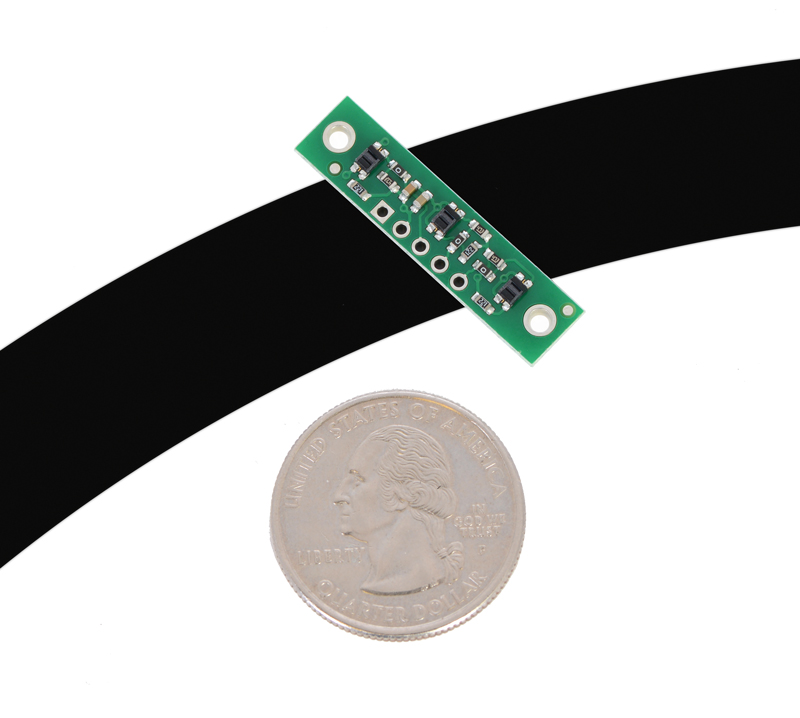
The LED current-limiting resistors are set to deliver approximately 17 mA to the LEDs when VCC is 5 V, making the total board consumption just over 50 mA. The schematic diagram of the module is shown below:
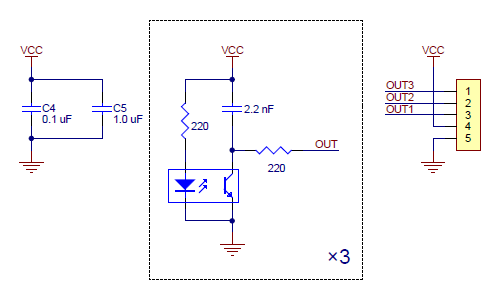
This schematic is also available as a downloadable pdf (117k pdf).
For an alternative array with eight sensors and the ability to turn off the IR LEDs to limit power consumption, consider our QTR-8RC reflectance sensor array. For individual reflectance sensors, consider our QTR-1RC and QTR-L-C1R.
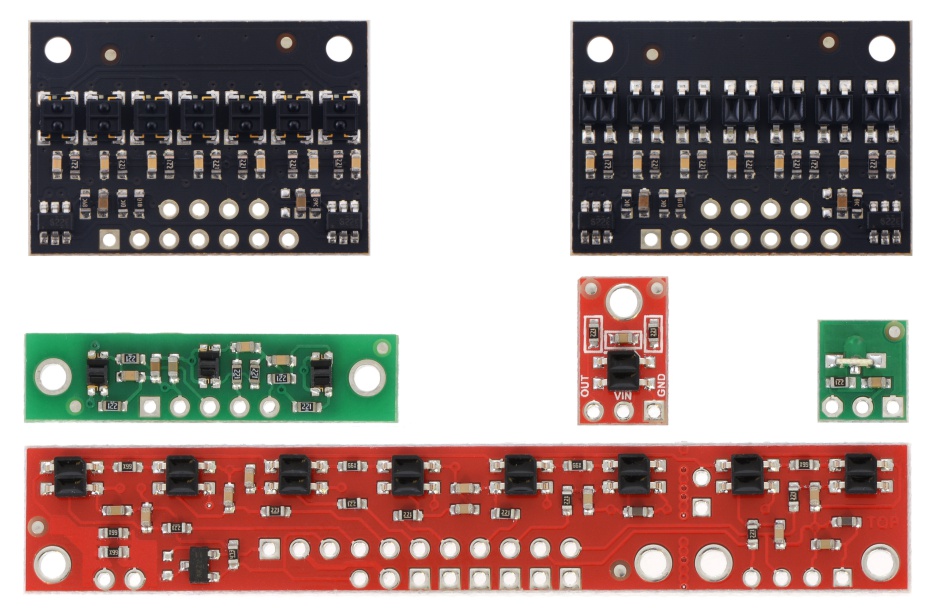
QTR sensor size comparison. Top row: QTRX-HD-07, QTR-HD-07; middle row: QTR-3, QTR-1, QTR-L-1; bottom row: QTR-8.
Specifications
• Dimensions: 1.25" x 0.3" x 0.1" (32 mm x 8 mm x 3 mm) (without header pins installed)
• Operating voltage: 5.0 V
• Supply current: 50 mA
• Output format: 3 digital I/O-compatible signals that can be read as a timed high pulse
• Optimal sensing distance: 0.125" (3 mm)
• Maximum recommended sensing distance: 0.25" (6 mm)
• Weight without header pins: 0.02 oz (0.6 g)
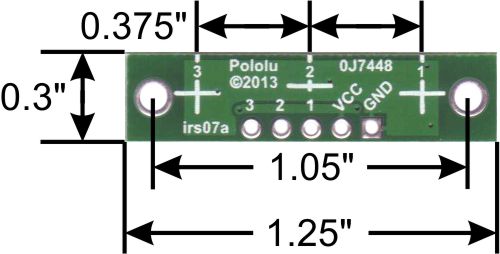
Interfacing the QTR-3RC Outputs to Digital I/O Lines
The QTR-3RC module has three identical sensor outputs that, like the Parallax QTI, require a digital I/O line capable of driving the output line high and then measuring the time for the output voltage to decay. The typical sequence for reading a sensor is:
1. Set the I/O line to an output and drive it high.
2. Wait several microseconds to give the 2.2 nF capacitor node time to reach 5 V.
3. Make the I/O line an input (high impedance).
4. Measure the time for the capacitor node voltage to decay by waiting for the I/O line to go low.
These steps can typically be executed in parallel on multiple I/O lines.
With a strong reflectance, the decay time can be as low as several dozen microseconds; with no reflectance, the decay time can be up to a few milliseconds. The exact time of the decay depends on your microcontroller’s I/O line characteristics. Meaningful results can be available within 1 ms in typical cases (i.e. when not trying to measure subtle differences in low-reflectance scenarios), allowing up to 1 kHz sampling of all three sensors.
The Pololu AVR library provides functions that make it easy to use these sensors with Orangutan robot controllers. We also have a Arduino library for these sensors.
Specifications
Dimensions
| Size: | 1.25" x 0.3"1 |
| Weight: | 0.6 g2 |
General specifications
| Supply current: | 50 mA |
Notes:
1 Mounting holes can be cut/ground off to decrease with to under 1".
2 Without included optional headers.
Don't delay, buy today.
Add to cart now!
Reviews
Customers who bought this product also bought:
-
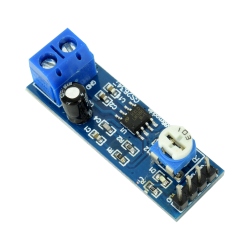
LM386 Audio...
High gain audio amplifier based on the LM386...
$1.56
-
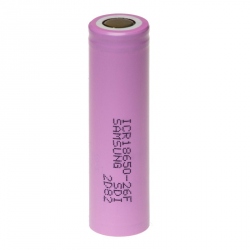
Samsung 2600...
Samsung 2600 mAh 18650 Li-Ion Battery -...
$4.68
-
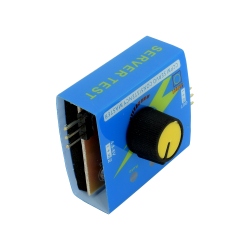
Servo Motor...
This is a servo motor tester with 3 modes. It...
$2.40
-
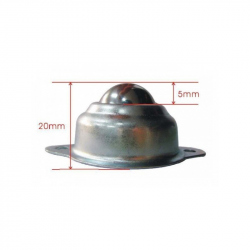
Ball Caster
Ball Caster See description for more details...
$0.95
-
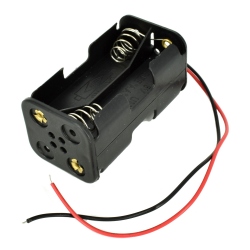
4xR6 Square...
This battery case can hold 4 x AA batteries...
$1.28
-
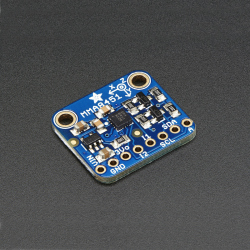
Adafruit...
So many accelerometers and so little time!...
$14.40
-
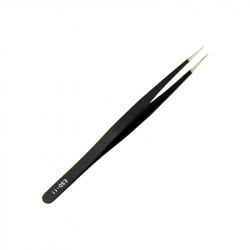
ESD-11...
This straight tweezer is made of high quality...
$0.76
-
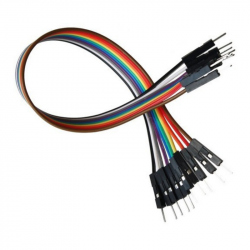
15 cm 10p...
15 cm 10p Male-Male Wires See description for...
$0.96
-
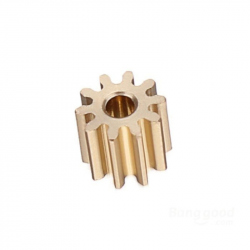
10-2A Metal...
10-2A Metal Gear See description for more...
$0.96
-

Long...
Long Hexagonal Motor Coupling Hub (4 mm) Gold...
$1.44




